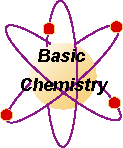Simplest Formula of a Compound
Practice Problem
If 0.87 g of silver reacted completely with sulfur and formed 1.0 g of silver sulfide, what would be the simplest formula? Hint: use moles.
Purpose:
To make an oxide of magnesium or a sulfide of copper and determine the simplest formula of the resulting compound.
Procedure:
- Heat a crucible and cover on a pipestem triangle strongly for three minutes to drive off moisture. The crucible should be handled with tongs from this point on so you don't burn your fingers or put oils from your fingers on the crucible.
- Weigh the cooled crucible and cover.
- Measure out 50 cm. of magnesium, sandpaper to a shiny luster and twist around a pencil to make a small volume OR use 1.0 g copper wire and mush into a ball.
- Add the metal to the crucible, cover it and weigh the whole thing.
- With the magnesium heat the contents with the cover off. If it flames up, cover it to put the flames out. The magnesium should be heated until it glows orange. With copper you will cover the metal with sulfur and heat strongly in the hood with the fan on. The cover should be on loosely and a blue flame will be seen around the cover.
- After the reaction is complete as seen by orange magnesium or no more blue flames coming from the copper then let the crucible and it's contents COOL and reweigh.
- If you used copper add another 2.0 g of sulfur and reheat to no flame. If using magnesium just heat again with the cover off.
- Allow the crucible and compounds to cool and reweigh.
Discussion:
- Why are steps 7 and 8 done?
- Describe the product.
- How many moles of metal and non-metal did you have?
- Give the metal/non-metal ratio. In most simple compounds the mole ratio can be expressed as a ratio of small integers, such as 1:1, 1:2, 3:2 etc. Round off your experimental mole ratio to obtain a ratio like the one cited here. What is the simplest formula for your compound?
- Compare your formula to one using the valence electrons.
- Find the % of metal in your compound. Find the % of metal in the compound having the simplest formula. Calculate your percent error, assuming the true value is that obtained from the simplest formula.
- Make an electron dot diagram of the chemical reaction that occured showing the reactants and product. Show the electron configuration of all elements in the reaction.
- Discuss your experimental results.
Back to top
If 0.87 g of silver reacted completely with sulfur and formed 1.0 g of silver sulfide, what would be the simplest formula? Hint: use moles.
- Heat a crucible and cover on a pipestem triangle strongly for three minutes to drive off moisture. The crucible should be handled with tongs from this point on so you don't burn your fingers or put oils from your fingers on the crucible.
- Weigh the cooled crucible and cover.
- Measure out 50 cm. of magnesium, sandpaper to a shiny luster and twist around a pencil to make a small volume OR use 1.0 g copper wire and mush into a ball.
- Add the metal to the crucible, cover it and weigh the whole thing.
- With the magnesium heat the contents with the cover off. If it flames up, cover it to put the flames out. The magnesium should be heated until it glows orange. With copper you will cover the metal with sulfur and heat strongly in the hood with the fan on. The cover should be on loosely and a blue flame will be seen around the cover.
- After the reaction is complete as seen by orange magnesium or no more blue flames coming from the copper then let the crucible and it's contents COOL and reweigh.
- If you used copper add another 2.0 g of sulfur and reheat to no flame. If using magnesium just heat again with the cover off.
- Allow the crucible and compounds to cool and reweigh.
- Why are steps 7 and 8 done?
- Describe the product.
- How many moles of metal and non-metal did you have?
- Give the metal/non-metal ratio. In most simple compounds the mole ratio can be expressed as a ratio of small integers, such as 1:1, 1:2, 3:2 etc. Round off your experimental mole ratio to obtain a ratio like the one cited here. What is the simplest formula for your compound?
- Compare your formula to one using the valence electrons.
- Find the % of metal in your compound. Find the % of metal in the compound having the simplest formula. Calculate your percent error, assuming the true value is that obtained from the simplest formula.
- Make an electron dot diagram of the chemical reaction that occured showing the reactants and product. Show the electron configuration of all elements in the reaction.
- Discuss your experimental results.
Back to top


